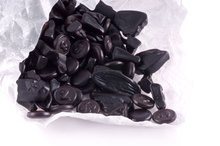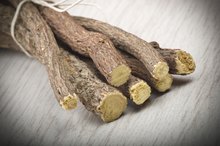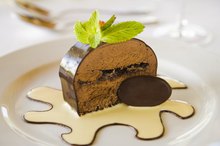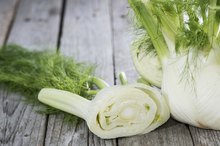What does fact checked mean?
At Healthfully, we strive to deliver objective content that is accurate and up-to-date. Our team periodically reviews articles in order to ensure content quality. The sources cited below consist of evidence from peer-reviewed journals, prominent medical organizations, academic associations, and government data.
The information contained on this site is for informational purposes only, and should not be used as a substitute for the advice of a professional health care provider. Please check with the appropriate physician regarding health questions and concerns. Although we strive to deliver accurate and up-to-date information, no guarantee to that effect is made.
Does Fennel Contain Black Licorice?
Fennel and black licorice are two separate plants. The licorice plant is a legume, and its root is used as a flavoring and spice. Fennel is an aromatic plant with edible stalks. It is also used as an herb. Although fennel tastes like black licorice, it has little else in common with licorice. Enjoy each plant for its distinct properties.
Fennel
Fennel, or Foeniculum vulgare, is a tall, flowering perennial. There are many varieties of fennel, including German, Russian, Persian, Indian, Japanese and Romanian. According to the "Encyclopedia of Herbs," the United States imports the majority of its fennel from Egypt. Dried fennel seeds have both medicinal and culinary uses. Fennel can also be eaten raw or cooked. Many people add the stalks and the bulbs to their salads. A distinct characteristic of fennel is that it often attracts shallowtail anise butterflies, to the delight horticulturalists and botanists.
- Fennel, or Foeniculum vulgare, is a tall, flowering perennial.
- According to the "Encyclopedia of Herbs," the United States imports the majority of its fennel from Egypt.
Licorice Root
Does Black Licorice Help Induce Labor
Learn More
Licorice is a plant whose root and rhizome yields an essential oil used for medicinal and flavoring purposes. Its distinct flavor comes from a compound exclusive to licorice called glycyrrhizin. Licorice root is used to treat ailments including sore throat, bronchitis, stomach ulcers and viral infections, although there is no substantive evidence that licorice can effectively treat any condition, according to the National Center for Complementary and Alternative Medicine 1. As a matter of fact, evidence suggests that large amounts of glycyrrhizin can cause sodium and water retention, low potassium and high-blood pressure. Large amounts can also cause preterm labor. Consuming licorice in tandem with diuretics can lead to potassium deficiency.
- Licorice is a plant whose root and rhizome yields an essential oil used for medicinal and flavoring purposes.
- As a matter of fact, evidence suggests that large amounts of glycyrrhizin can cause sodium and water retention, low potassium and high-blood pressure.
Black Licorice
Black licorice is a candy flavored with licorice-root essential oil, glybcyrrhizic acid or anise oil. Although many fruit-flavored licorice candies are on the market today, only black licorice is meant to taste like licorice root.
Association
Licorice Root & Smoking
Learn More
Given that they are distinctly different, why is it that fennel and licorice are often confused for one another? The answer is that fennel and glycyrrhizin have very similar flavors. Moreover, a third food additive, anise, also tastes and smells quite similar to both licorice and fennel, leading to further confusion. In essence, anything with this particular flavor could contain any of these plants or a combination.
- Given that they are distinctly different, why is it that fennel and licorice are often confused for one another?
- The answer is that fennel and glycyrrhizin have very similar flavors.
Related Articles
References
- National Center for Complimentary and Alternative Medicine: Licorice Root
- "The Encyclopedia of Herbs: A Comprehensive Reference to Herbs of Flavor and Fragrance"; Arthur O. Tucker and Thomas DeBaggio; 2009
- "Practical Guide to Natural Medicines"; Andrea Pierce; 1999
- Licorice. FoodData Central. U.S. Department of Agriculture. Published April 1, 2020.
- Glycemic Index of Foods. Sydney University’s Glycemic Index Research Service. Updated November 26, 2019
- Menopausal Hormone Therapy and Cancer Risk. American Cancer Society. Updated February 13, 2015
- Boonmuen N, Gong P, Ali Z, et al. Licorice root components in dietary supplements are selective estrogen receptor modulators with a spectrum of estrogenic and anti-estrogenic activities. Steroids. 2016;105:42-9. doi:10.1016/j.steroids.2015.11.006
- Mousa HA. Prevention and treatment of influenza, influenza-like illness, and common cold by herbal, complementary, and natural therapies. J Evid Based Complementary Altern Med. 2017;22(1):166-174. doi:10.1177/2156587216641831
- Raveendra KR, Jayachandra, Srinivasa V, et al. An extract of glycyrrhiza glabra (GutGard) alleviates symptoms of functional dyspepsia: A randomized, double-blind, placebo-controlled study. Evid Based Complement Alternat Med. 2012;2012:216970. doi:10.1155/2012/216970
- Rahnama M, Mehrabani D, Japoni S, Edjtehadi M, Saberi Firoozi M. The healing effect of licorice (Glycyrrhiza glabra) on Helicobacter pylori infected peptic ulcers. J Res Med Sci. 2013;18(6):532-3.
- Huang QC, Wang MJ, Chen XM, et al. Can active components of licorice, glycyrrhizin and glycyrrhetinic acid, lick rheumatoid arthritis?. Oncotarget. 2016;7(2):1193-202. doi:10.18632/oncotarget.6200
- Yan T, Wang H, Cao L, et al. Glycyrrhizin alleviates nonalcoholic steatohepatitis via modulating bile acids and meta-inflammation. Drug Metab Dispos. 2018;46(9):1310-1319. doi:10.1124/dmd.118.082008
- American College of Allergy, Asthma & Immunology. Food allergy. Updated 2014.
- U.S. Food & Drug Administration. Black Licorice: Trick or Treat?. Updated November 2017.
- Muñoz Balbontín Y, Stewart D, Shetty A, Fitton CA, Mclay JS. Herbal medicinal product use during pregnancy and the postnatal period: A systematic review. Obstet Gynecol. 2019;133(5):920-932. doi:10.1097/AOG.0000000000003217
Writer Bio
Naomi Parks has been a freelancing professional since 2004. She is a biochemist and professional medical writer with areas of interest in pulmonology, pharmaceuticals, communicable diseases, green living and animals. She received her Bachelor of Arts in biological anthropology from San Francisco University and her Master of Science in biochemistry from Pace University.









